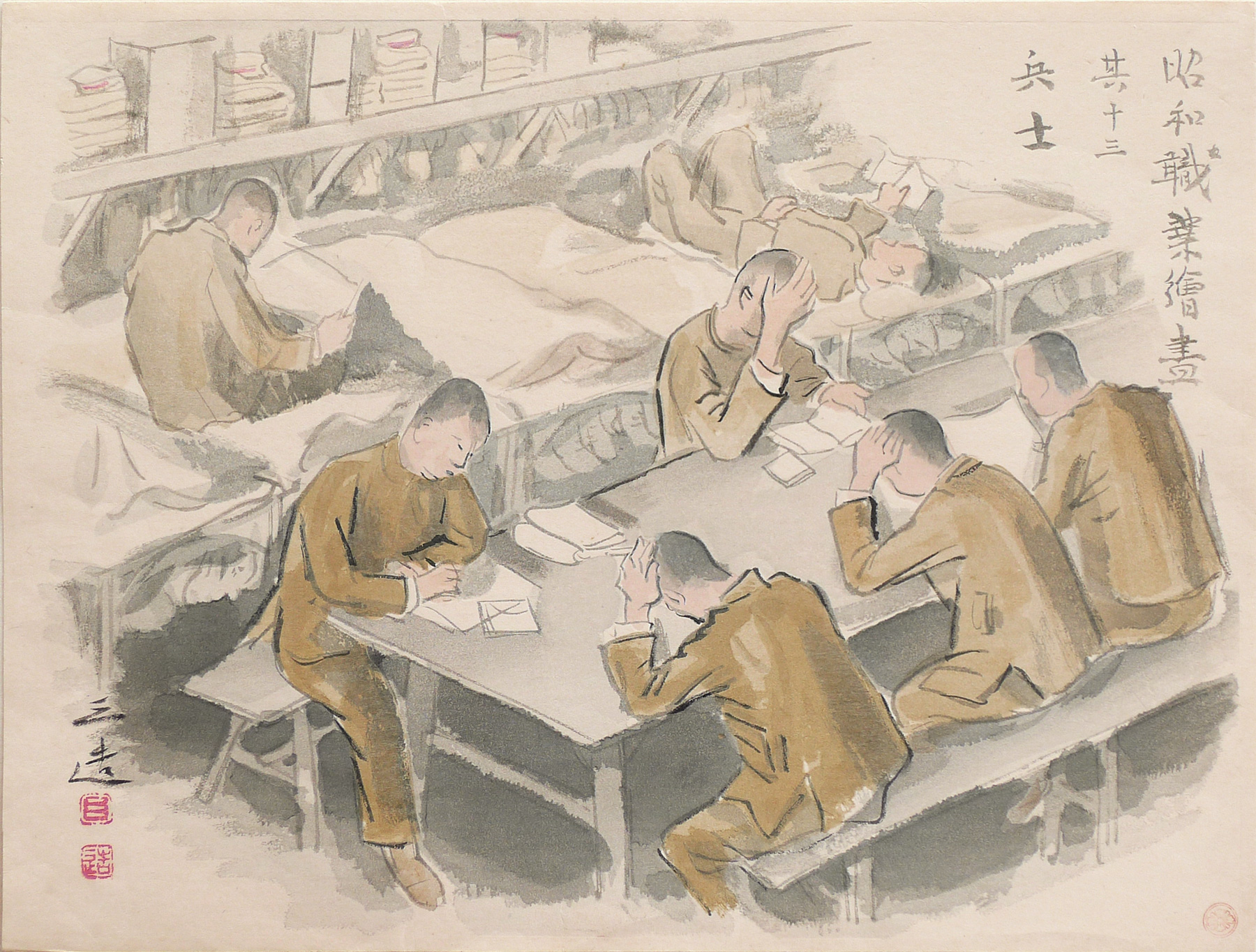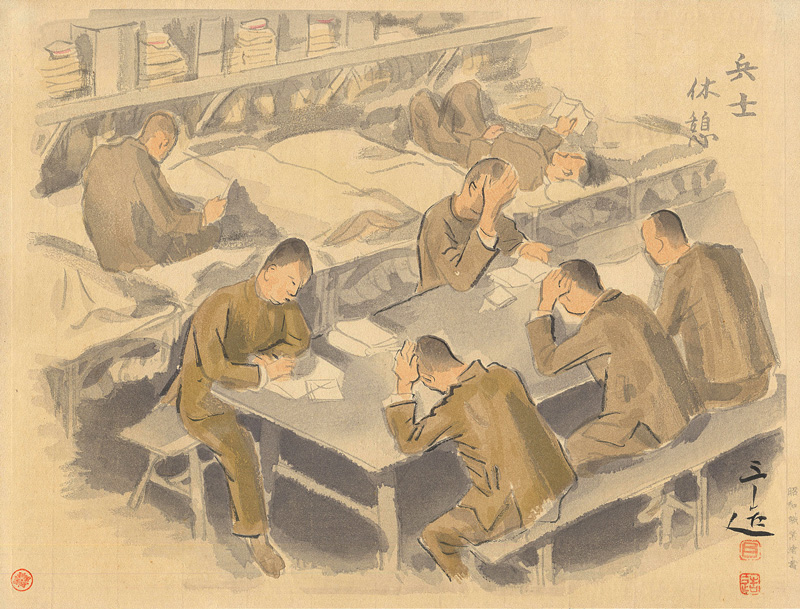About This PrintPicturing soldiers at rest, this print was originally issued between 1939 and 1941 by the publisher Nishinomiya Shoin. At least one other state of this print exists, also published by Nishinomiya Shoin and shown below. The major differences between this collection's print and the below state of the print are the shortened title used on this collection's print, 兵士 (Soldier), rather than 兵士休憩 (Resting Soldier); the placement of the series title 昭和職業絵盡 within the image on this collection's print, rather than in the lower right margin; and the positions of the artist's signature and the publisher's seal. It is unknown which state of the print was issued earliest. It appears that this print was not re-issued after the War by Kyoto Hangain, which reprinted many of the prints from the two pre-WWII series along with issuing a new third series of prints. This is not surprising, given that the depiction of war related themes was not a politically correct sentiment after the War and not a way to sell prints.
As described in Memories of Shōwa: Impressions of Working Life by Wada Sanzō, each print was originally released with an explanatory sheet by Wada in Japanese "containing detailed information and personal insights."1 Some of the accompanying commentaries were also translated into English by "Glenn W. Shaw (1881-1961), a writer and teacher who moved to Japan in 1913."2 The following commentary, which did not accompany this collection's print, is copied from Memories of Shōwa, as translated by the authors.3
Our soldiers, who are the ones who ought to bear the greatest responsibility in these important times, are usually trained under the simple and strict command of tradition.
Therefore in the barracks they become absolutely emotionless, expressionless, and selfless. In addition, they all talk the same and move like machines.
Even when they are off-duty and, for example, write letters or read magazines, the simple and concise room overflows with spirit, and you can feel a dynamic strength.
In response to the many banners with "to laugh and cry together" and "be bright and cheerful today", those who visit can only take their hat off to them.
|
1 Memories of Shōwa: Impressions of Working Life by Wada Sanzō, Maureen de Vries and Daphne van der Molen, Nihon no hanga, 2021, p. 14. 2 ibid. 3 ibid, p. 28.
A Critical View Source: Light in Darkness: Women in Japanese Prints of Early Shōwa (1926-1945), Kendall H. Brown, et. al., Fisher Gallery, University of Southern California, 1996, p. 12. In the introduction to the catalog of the exhibition Light in Darkness: Women in Japanese Prints of Early Shōwa (1926-1945), Dr. Kendall H. Brown, in commenting on the two pre-War series states: | The majority of thesewartime prints show male occupations but give little sense of Japan’s militaryinvolvements or even Japan’s status as a highly industrialized country. (These characteristics may account for the popularityof the series when reissued after the war.) Only a few prints show military men, and, not surprisingly, they displaysoldiers in non-military activities such as relaxing in their bunks orstudying. |
An Additional Print State from Nishinomiya Shoin Titled Soldiers Resting (兵士休憩 heishi kyūkei)
About the Series "Occupations of Shōwa Japan in Pictures"
Sources: website of Ross Walker Ohmi Gallery http://www.ohmigallery.com/DB/Artists/Sales/Wada_Sanzo.asp and website of USC Pacific Asian Museum "Exhibition - The Occupations of Shōwa Japan in Pictures: The Woodblock Prints of Wada Sanzō"
Note:
My special thanks to Shinagawa Daiwa, the current owner of Kyoto Hangain, for providing the below information (in a series of emails in July 2014) about Nishinomiya Shoin and Kyoto Hangain, both businesses started by his father Shinagawa Kyoomi. Shinagawa's current website can be accessed at http://www.amy.hi-ho.ne.jp/kyotohangain/ Wada’s major contribution as a woodblock print artist came through his 72 print 3-part series Occupations of Shōwa Japan in Pictures (Shōwa shokugyō e-zukishi), also translated as Occupations of the Shōwa Era in Pictures and Japanese Vocations in Pictures. The three part series was started during the Pacific War (1937-1945) in September 1938, was then interrupted by war shortages in 1943, and was restarted again after the war in January 1954. This series was a labor of love for Wada and he brought together woodblock print printers and carvers in Nishimomiya near Kobe to work on this project.
The war era prints were published by Wada through an old books store, Nishinomiya shoin 西宮書院 run by Shinagawa Kyoomi planned a total of 100 designs, with two prints being issued each month. Wada's designs for the prints were rendered in watercolor and the finished prints beautifully captured the look-and-feel of those original watercolors. The series was an immediate hit, but was suspended after 48 prints (issued in two series) in 1943 due to war shortages. After the war, the series was continued by the same publisher, Shinagawa Kyoomi, who had opened a new business in Kyoto, which he named Kyoto Hangain 京都版画院. (Shingawa's business in Nishinomiya had burned down during WWII.) At first Kyoto Hangain published re-prints of the earlier prints, but they went on to publish a third series of 24 prints, working closely with Wada, titled Continuing Occupations of Shōwa Japan in Pictures between November 1954 and September 1956.1 The post-war prints were popular with the Occupation's "deep-pocketed" military and civilian personnel and the series was "featured in an article of the Tokyo edition of the United States military newspaper Stars and Stripes."2 Shinagawa also published a six print portfolio in the 1950s titled Japanese Life and Customs, consisting of six of the prints from the earlier two series in a reduced chuban size, which is also part of this collection. Occupations of Shōwa Japan in Pictures has been praised for showing “the complexity of Shōwa society…. capture[ing] the pulse of Japanese life during the tumultuous decades of the 1930s, 1940s and 1950s”3 and condemned as providing a “visual message of subtle or blatant propaganda in support of government-sponsored ideas.”4 It is interesting to see how the commentary, written by the artist, that accompanied each print in the pre-war releases was softened for the post-war re-issues by Kyoto Hangain. All references to soldiers being away from home (as Japanese armies were marching through Asia when the series was originally released) or references to Imperial Japan have been stripped away and the commentary becomes innocent, folk-like and appealing to the post-war occupying forces. (For example, see the prints Women Weavers and Picture Card Show which provide the artist's original commentary and a full transcript of the English text attached to the folders of the post-war re-issued prints.)
1 Keizaburo Yamaguchi gives the publication dates of the post-War series as January 1954 through autumn 1958. (Ukiyo-e Art 16, 1967): 39-42. 2 "Out of the Dark Valley: Japanese Woodblock Prints and War, 1937-1945," Kendall H. Brown,p. 82 appearing in Impressions, The Journal of the Ukiyo-e Society of America, Inc., Number 23, 2001.3 Pacific Asia Museum website http://www.pacificasiamuseum.org/_on_view/exhibitions/2004/occshowa.aspx 4 Light in Darkness: Women in Japanese Prints of Early Shōwa (1926-1945), Kendall H. Brown, et. al., Fisher Gallery, University of Southern California, 1996, p. 18.
Print Details | IHL Catalog | #1022 | | Title/Description | 兵士 [heishi] 其十三 - Soldiers, number 13 | | Series | Occupations of Shōwa Japan in Pictures, Series 1 (also seen translated as "Compendium of Occupations in the Shōwa Era" and "Japanese Vocations in Pictures")
Shōwa shokugyō e-zukushi 昭和職業繪盡 (also seen written as 昭和職業絵尽し and
昭和職業繪盡し), daiishū (第一輯) | Artist
| Wada Sanzō (1883-1967)
| Signature
| 三造 Sanzō | | Seal | "San" and "zō" - seals of artist | | Publication Date | 1939-1941
| | Publisher | Nishinomiya Shoin 西宮 書院 | | Edition | first edition
| | Impression | excellent | | Colors | excellent | | Condition | good - light overall toning; stain lower right; glue remnants top corners verso from removal from original folio
| | Genre | shin hanga
| | Miscellaneous | originally released by Nishinomiya Shoin as print number 13 (十三) in series 1 | | Format | dai-oban
| | H x W Paper | 11 1/4 x 15 in. (28.6 x 38.1 cm)
| | H x W Image | 10 3/4 x 14 1/2 in. (27.3 x 36.8 cm) | | Collections This Print | Himeji City Museum of Art Ⅲ-183-13 (dated "1939~1940年"); British Museum 2003,0816,0.7 | | Reference Literature | Memories of Shōwa: Impressions of Working Life by Wada Sanzō, Maureen de Vries and Daphne van der Molen, Nihon no hanga, 2021 |
last revision:8/9/2021 12/5/2018 |





